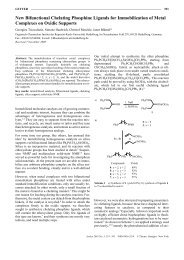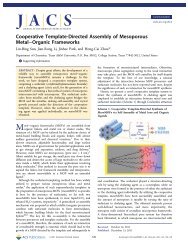Singlet Fission - Department of Chemistry
Singlet Fission - Department of Chemistry
Singlet Fission - Department of Chemistry
You also want an ePaper? Increase the reach of your titles
YUMPU automatically turns print PDFs into web optimized ePapers that Google loves.
AD Chemical Reviews, XXXX, Vol. xxx, No. xx Smith and Michl<br />
excited states are not <strong>of</strong> much relevance in the present<br />
context. In the low-resolution absorption spectrum <strong>of</strong> the S0<br />
state <strong>of</strong> the isolated molecule <strong>of</strong> 3, the La band is located at<br />
2.1-2.7 eV and its vibrational structure consists <strong>of</strong> four peaks<br />
separated by ∼1500 cm -1 .<br />
Although really accurate calculations for a molecule <strong>of</strong><br />
the size <strong>of</strong> 3 are difficult, many more or less approximate<br />
calculations have been published and reproduce the main<br />
spectral features <strong>of</strong> the isolated molecule within 0.2-0.3 eV.<br />
Recent examples are single-reference TD-DFT 30,181 and<br />
CC2 182 and multireference CAS-MP2 40 calculations. Multireference<br />
calculations were used to obtain useful results for<br />
doubly excited states.<br />
Properties <strong>of</strong> Gas Phase and Rare-Gas Matrix Isolated<br />
3. In isolated molecules cooled in a supersonic jet, the La<br />
band origin occurs at E(S1) ) 2.31 eV. 183-185 Fluorescence<br />
originates in the same state and is a fairly close mirror image<br />
<strong>of</strong> the absorption. Low-temperature matrix-isolation absorption<br />
and emission spectra 186,187 are similar to the jet-cooled<br />
spectra, but somewhat red-shifted. In a neon (krypton)<br />
matrix, 188 the shift <strong>of</strong> the 0-0 transition is ∼0.025 (∼0.125)<br />
eV relative to the gas phase. There are no indications <strong>of</strong> a<br />
presence <strong>of</strong> additional electronic transitions nearby. These<br />
results leave no doubt that in an isolated molecule <strong>of</strong> 3 the<br />
optically allowed La state is the lowest excited singlet and<br />
that the probably present recently calculated doubly excited<br />
singlet state must lie above La, not below as proposed. 40<br />
Flash photolysis <strong>of</strong> the vapor 189 yields a transient whose<br />
absorption spectrum lasts for tens <strong>of</strong> µs and which was<br />
assigned to the T1 state. It contains four intense peaks starting<br />
at 2.68 eV, separated by ∼0.17 eV. If the T1 state also<br />
absorbs at lower energies, it does so only very weakly.<br />
For a hydrocarbon, the gas-phase ionization potential <strong>of</strong><br />
3 is unusually low, 6.61 eV, 190 and electron affinity is<br />
unusually high, 1.35 eV. 191 Gas-phase spectra <strong>of</strong> the radical<br />
cation and the radical anion do not appear to have been<br />
reported, but rare-gas matrix absorption spectra are known<br />
and resemble each other closely, 188 as expected from the<br />
alternant pairing theorem. 192 In both cases, the lowest-energy<br />
absorption peaks occur near 1.3-1.4 eV and are due to two<br />
nearly degenerate transitions. The radical cation has a 2 B3g<br />
ground state, and the two transitions are to states <strong>of</strong><br />
symmetries 2 B1u (y-polarized) and 2 Au (stronger, x-polarized).<br />
In a Ne matrix, they lie at 1.26 and 1.31 eV, respectively.<br />
They are red-shifted by ∼0.01 and ∼0.025 eV, respectively,<br />
in a Kr matrix. The radical anion has a 2 B1u ground state,<br />
and the two transitions are to states <strong>of</strong> symmetries 2 B3g<br />
(y-polarized) and 2 B2g (stronger, x-polarized). In a Ne matrix,<br />
they occur at 1.37 and 1.41 eV, respectively. They are again<br />
red-shifted, by ∼0.01 and ∼0.025 eV, respectively, in a Kr<br />
matrix.<br />
Properties <strong>of</strong> 3 in Solutions. Solution absorption spectra<br />
closely resemble the gas-phase and rare-gas matrix spectra<br />
but are broadened and considerably red-shifted. In benzene,<br />
the red shift from the gas phase amounts to ∼0.2 eV and<br />
E(S1) equals 2.15 193 (2.13 194 ) eV. In cyclohexane, the value<br />
reported as an average <strong>of</strong> the energies <strong>of</strong> the first peaks in<br />
absorption and in fluorescence is 2.10 eV. 128 The Stokes shift<br />
between these peaks is very small, e.g., in 2-methyltetrahydr<strong>of</strong>uran<br />
at 77 K, only 2 nm even without correction for<br />
self-absorption (in this solvent, E(S1) is 2.13 194 ).<br />
From phosphorescence in frozen cyclohexane, E(T1) is<br />
0.95 eV. 128 Early flash photolysis measurements in hexane 166,195<br />
revealed a transient with three absorption peaks separated<br />
by ∼1400 cm -1 and with the first peak at 2.51 eV in a<br />
spectrum that lasted for tens <strong>of</strong> µs. More recent work in<br />
benzene produced an essentially identical spectrum with the<br />
fourth peak now visible as an indistinct shoulder, and the<br />
first peak shifted to 2.46 eV. 193 The red shift <strong>of</strong> this fairly<br />
strong transition is thus again about 0.2 eV between gas phase<br />
and benzene solution. A search for weak absorption at<br />
energies as low as 1.1 eV did not reveal any, down to a<br />
sensitivity limit <strong>of</strong> 50 M -1 cm -1 (numerous calculations<br />
suggest that there is a very weakly allowed transition in the<br />
low-energy region, variously predicted for instance at 1.24 40<br />
or 1.41 182 eV). Several bands are present at higher energies,<br />
with the most intense one at 4.04 eV. A comprehensive<br />
determination <strong>of</strong> photophysical parameters in cyclohexane 128<br />
yielded the quantum yields <strong>of</strong> fluorescence, intersystem<br />
crossing, and internal conversion as 8, 76, and 16%, and a<br />
fluorescence lifetime as 7.0 ns, which corresponds to an<br />
intersystem crossing rate constant <strong>of</strong> ∼1.1 × 10 -8 s -1 .<br />
All the authors agree on the assignment <strong>of</strong> the ∼2.5 eV<br />
transient to T1 based on its long lifetime. The transient<br />
spectrum measured in benzene upon sensitization with triplet<br />
1 (54 µs single exponential lifetime) is identical with the<br />
spectrum obtained upon direct excitation, 194 proving the<br />
identity <strong>of</strong> this transient as triplet with certainty. There is<br />
no doubt that the T1 state is <strong>of</strong> HOMO-LUMO nature and<br />
that its symmetry is B2u. All computations since the pioneering<br />
semiempirical effort in 1956 47 have agreed that the<br />
intense transition at 2.4-2.7 eV is to a B1g state and is<br />
polarized along the long axis (x). In solution, the triplet reacts<br />
with ground-state 3 to yield a transient that absorbs in the<br />
UV and has a lifetime in the ms range. This was assigned to<br />
a thermally unstable photochemical dimer. 193<br />
Properties <strong>of</strong> Solid 3. The situation is complicated<br />
because 3 is known to crystallize in at least four polymorphs<br />
characterized by different layer periodicity. 196 The four have<br />
been grown as thin films and one also as a single crystal,<br />
whose structure has been determined. 196,197 The structure <strong>of</strong><br />
one form, obtained by vapor deposition <strong>of</strong> a fiber-structured<br />
very thin film on a suitable substrate, is known as well 198<br />
and is complicated in that the molecular arrangement within<br />
the unit cell depends on the substrate used. Unfortunately,<br />
in most optical studies <strong>of</strong> films, little attention was paid to<br />
the structural characterization <strong>of</strong> the film used.<br />
Nevertheless, all authors find similar general features <strong>of</strong><br />
single-crystal and polycrystalline film absorption. The first<br />
absorption band shows fairly broad peaks reminiscent <strong>of</strong><br />
those found in isolated molecules, but the first peak exhibits<br />
a 0.14 eV Davydov splitting 199,200 into a pair <strong>of</strong> peaks at<br />
1.83 106,201 and 1.97 201 eV, polarized parallel and perpendicular<br />
to the crystal b axis, respectively. 201 The others occur at 2.12<br />
and 2.3 eV 149,202 and have been assigned to intermolecular<br />
charge-transfer transitions. 106 The red shift <strong>of</strong> the average<br />
<strong>of</strong> the Davydov pair relative to the gas phase is 0.4 eV, twice<br />
the shift observed upon going from the gas phase to benzene<br />
solution.<br />
It was reported a long time ago that that solid 3 does not<br />
fluoresce detectably, 158 and there is general agreement on<br />
the subject. The E(T1) energy is 0.86 177 eV from the<br />
activation energy <strong>of</strong> heter<strong>of</strong>ission with 3 as a guest in host<br />
crystals <strong>of</strong> 2 and 0.85 eV from direct measurement on a<br />
film. 178 If the red shift from the gas phase to the solid were<br />
to be again the same for the strong absorption band <strong>of</strong> the<br />
T1 state as it is for the La transition from the S0 state (0.4<br />
eV), as is the case in benzene solution (0.2 eV), the average



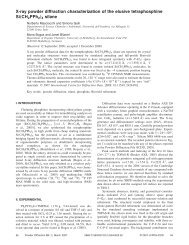

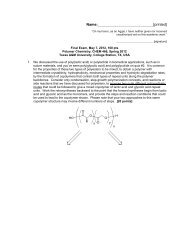

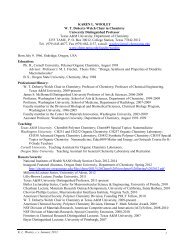
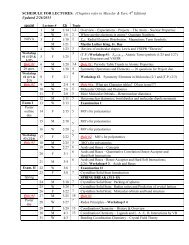
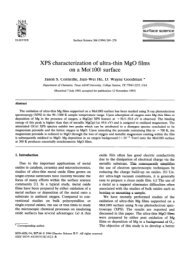
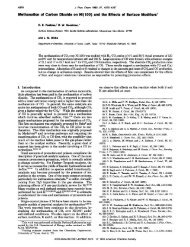
![Radical salts of TTF derivatives with the metal–metal bonded [Re2Cl8]](https://img.yumpu.com/10115211/1/190x253/radical-salts-of-ttf-derivatives-with-the-metal-metal-bonded-re2cl8.jpg?quality=85)



